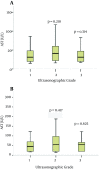Correlation of Body Mass Index and Serum Parameters With Ultrasonographic Grade of Fatty Change in Non-alcoholic Fatty Liver Disease
- PMID: 24719704
- PMCID: PMC3964422
- DOI: 10.5812/ircmj.12669
Correlation of Body Mass Index and Serum Parameters With Ultrasonographic Grade of Fatty Change in Non-alcoholic Fatty Liver Disease
Abstract
Background: Non-alcoholic fatty liver disease (NAFLD) is a common liver disease in the western population and expanding disease in the world. Pathological changes in fatty liver are like alcohol liver damage, which can lead to end-stage liver disease. The prevalence of NAFLD in obese or overweight people is higher than general population, and it seems that people with high Body Mass Index (BMI) or abnormality in some laboratory tests are more susceptible for severe fatty liver and high grade of NAFLD in ultrasonography (U.S).
Objectives: This study aimed to evaluate the correlation of BMI and laboratory tests with NAFLD in ultrasonography.
Materials and methods: During a multi-step process, we selected two-hundred and thirteen cases from four hundred and eighteen patients with NAFLD. Laboratory tests performed included: ALT, AST, FBS, Triglyceride and cholesterol levels, hepatitis B surface antigen, hepatitis C antibody, ceruloplasmin, serum iron, TIBC, transferrin saturation, ferritin, AMA, ANA, ANTI LKM1, serum protein electrophoresis, TSH, anti TTG (IgA). BMI and ultrasonography for 213 patients were performed, and then data was analyzed. These parameters and grades of ultrasonography were compared with the values obtained using one way ANOVA. An ordinal logistic regression model was used to estimate the probability of ultrasonography grade. The Statistical Package for the Social Science program (SPSS, version 16.0) was used for data analysis.
Results: Two-hundred and thirteen cases including 140 male and 73 female, were studied. In general, 72.3% of patients were overweight and obese. Post-hoc tests showed that only BMI (P < 0.001) and TG (P < 0.011) among variables had statistically significant associations with ultrasonography grade (USG), and ordinal logistic regression model showed that BMI and AST were the best predictors.
Discussion: Our results suggest that in patients with NAFLD, BMI and TG are most effective factors in severity of fatty liver disease and ultrasonography grade (USG). On the other hand, BMI as a predictor can be helpful. But, AST has not been a reliable finding, because it changes in many conditions.
Keywords: Aspartate Aminotransferase; Body Mass Index; Non-alcoholic Fatty Liver Disease; Triglyceride; Ultrasonography.
Figures


Similar articles
-
[Lipid metabolism in non-alcoholic fatty liver disease in patients with different body weights in mid-mountain conditions].Ter Arkh. 2023 Jan 16;94(12):1361-1366. doi: 10.26442/00403660.2022.12.201998. Ter Arkh. 2023. PMID: 37167179 Russian.
-
Obesity and metabolic syndrome as risk factors for the development of non-alcoholic fatty liver disease as diagnosed by ultrasound.Vojnosanit Pregl. 2016 Oct;73(10):910-20. doi: 10.2298/VSP150514093P. Vojnosanit Pregl. 2016. PMID: 29327896
-
Prevalence, characteristics, and risk factors of non-alcoholic fatty liver disease in North East of Iran: a population-based study.BMC Gastroenterol. 2024 Jun 26;24(1):212. doi: 10.1186/s12876-024-03302-y. BMC Gastroenterol. 2024. PMID: 38926664 Free PMC article.
-
Utility of MR proton density fat fraction and its correlation with ultrasonography and biochemical markers in nonalcoholic fatty liver disease in overweight adolescents.J Pediatr Endocrinol Metab. 2020 Apr 28;33(4):473-479. doi: 10.1515/jpem-2019-0463. J Pediatr Endocrinol Metab. 2020. PMID: 32146441
-
Efficacy and safety of dietary polyphenol supplementation in the treatment of non-alcoholic fatty liver disease: A systematic review and meta-analysis.Front Immunol. 2022 Sep 9;13:949746. doi: 10.3389/fimmu.2022.949746. eCollection 2022. Front Immunol. 2022. PMID: 36159792 Free PMC article.
Cited by
-
Prevalence of Nonalcoholic Fatty Liver Disease and its Related Metabolic Risk Factors in Isfahan, Iran.Adv Biomed Res. 2017 Apr 17;6:47. doi: 10.4103/2277-9175.204590. eCollection 2017. Adv Biomed Res. 2017. PMID: 28503502 Free PMC article.
-
The role of anthropometric indices in the prediction of non-alcoholic fatty liver disease in the PERSIAN Guilan Cohort study (PGCS).J Med Life. 2018 Jul-Sep;11(3):194-202. doi: 10.25122/jml-2018-0031. J Med Life. 2018. PMID: 30364682 Free PMC article.
-
Effect of Aerobic and Resistance Exercise Training on Liver Enzymes and Hepatic Fat in Iranian Men With Nonalcoholic Fatty Liver Disease.Hepat Mon. 2015 Oct 10;15(10):e31434. doi: 10.5812/hepatmon.31434. eCollection 2015 Oct. Hepat Mon. 2015. PMID: 26587039 Free PMC article.
-
TBH score: a new model to predict and prevent severe liver damage after chemotherapy for cancer patients.Cancer Manag Res. 2019 Jul 11;11:6443-6456. doi: 10.2147/CMAR.S199967. eCollection 2019. Cancer Manag Res. 2019. PMID: 31372047 Free PMC article.
-
MR spectroscopy of the liver - a reliable non-invasive alternative for evaluating non-alcoholic fatty liver disease.Rom J Morphol Embryol. 2020;61(1):73-80. doi: 10.47162/RJME.61.1.08. Rom J Morphol Embryol. 2020. PMID: 32747897 Free PMC article.
References
-
- Fan JG, Peng YD. Metabolic syndrome and non-alcoholic fatty liver disease: Asian definitions and Asian studies. Hepatobiliary Pancreat Dis Int. 2007;6(6):572–8. - PubMed
LinkOut - more resources
Full Text Sources
Other Literature Sources
Miscellaneous
